Sigma 50-500 mm f/4.5-6.3 APO DG OS HSM
3. Build quality and image stabilization
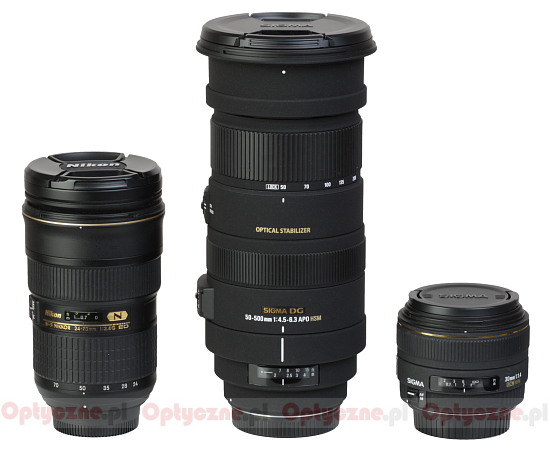 |
At first glance the Sigma 50-500 mm OS is similar to the cheaper 150-500 mm f/5.0–6.3 APO DG OS HSM model but on closer inspection you can notice several minor differences. The build quality is not among them though – both lenses appear to be made of very similar, tough materials, and seem to be really solid. Although we don’t deal here with the high-end EX series, I suppose the Sigma 50-500 mm OS would easily deserve that prestigious symbol. The lack of it is most probably a result of new Sigma tactics, according to which only prime lenses or standard zooms qualify for the EX series. Anyway we didn’t manage to find one single element in the new model which would be worse than in the old Bigma and, after all, the older version boasted EX letters in its name.
Please Support UsIf you enjoy our reviews and articles, and you want us to continue our work please, support our website by donating through PayPal. The funds are going to be used for paying our editorial team, renting servers, and equipping our testing studio; only that way we will be able to continue providing you interesting content for free. |
- - - - - - - - - - - - - - - - - - - - - - - - - - - - - - - - - - - - - - - - - - - - - - - -
The parameters did change, compared to the predecessor, though. The new lens is slower at the short end – its fastness changed from f/4.0 to f/4.5. What’s interesting, the size of the front element increased so the filter thread amounts now to 95 mm in diameter, a monstrous size indeed (but we do get a 86 mm step-down ring among accessories supplied and it is supposed to not cause any vignetting on APS-C/DX image sensors). In exchange, we were given something very important. The old Bigma’s minimal focus was at 1 meter and it was a very good result. The minimum focusing distance of two new models, a 120–400 mm OS and a 150–500 mm OS, were 1.5 and 2.2 meters respectively and they left us a bit unsatisfied. The new Bigma’s minimum focus distance is already 0.5 meter at 50 mm and 1.8 meters at 500 mm. It gives us the maximum magnification ratio of 1:3.1 at 200 mm focal length and it makes this lens also a very interesting device for macro mode shots.
The worsening of fastness has also less pleasant consequences, though. At the longer end the new Sigma’s relative aperture amounts to f/6.3. Unfortunately it is true not only at 500 mm but also at 400, 300 and even at 220 mm. It changes into f/5.6 only near that last focal length. Such a result is very weak indeed. Much cheaper, low-end 70-300 mm class devices boast the fastness of f/5.6 at 300 mm. It is difficult to say why the Sigma 50-500 mm, equipped with a huge front element, doesn’t have it there. However, it is undoubtedly a serious flaw.
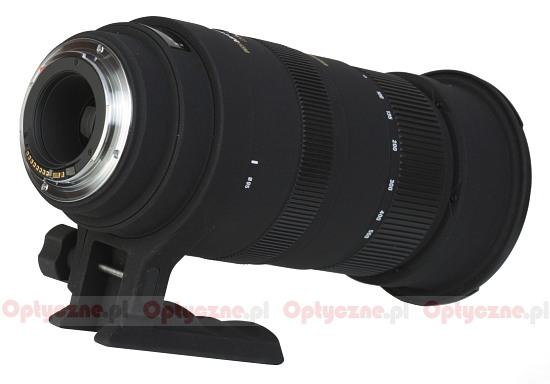 |
The Sigma 50–500 mm f/4.5–6.3 APO DG OS HSM starts with a metal bayonet mount which surrounds the rear element with a diameter of less than 2 cm. When the lens is maximally folded, so set at 50 mm focal length, the rear element is hidden about 1.5 cm inside the barrel. When we pass to the 500 mm focal length that depth increases to more than 5 centimeters.
Immediately after the mount, already on the lens’s barrel, we see a distance scale window, with markings expressed in feet and meters. Then we encounter a ring for attaching a solid tripod socket, included in box. Behind the tripod socket on the left (looking from the side of the body) we find focus mode switches (AF/MF) and optical stabilization OS switches (OFF, mode 1, mode 2). At the same level as these switches there is also a plate with the name of the lens and its parameters.
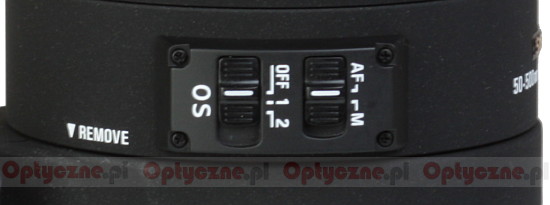 |
The next element is a manual focus ring, working full time -both in the AF and in the MF mode. The ring is almost three centimeters wide but its ribbed section is only 18 mm wide. That width is quite enough to ensure a fully comfortable grip, though. The ring is well-damped and allows you to make very precise movements. Running through the whole scale takes a 140-degree turn.
Behind that ring we find an „OPTICAL STABILIZER” inscription and on the left from that a LOCK/UNLOCK switch, used to block the lens in folded position at 50 mm. It is a very useful solution because when you point the lens downwards you might get a zoom creep – the lens changes the focal length from 50 mm to near 200 mm automatically. The situation is better the other way round – the lens set at 500 mm doesn’t have any collapsing tendencies and stays put in the set place.
The zoom ring is four centimeters wide and very comfortable to use. It moves smoothly with equal resistance throughout the whole focal lengths range. On passing from 50 mm to 500 mm the lens increases its length from less than 22 centimeters to almost 31 centimeters.
The lens ends with a huge, non-rotating filter thread with a diameter of 95 mm. That size is caused by a huge front element, as big as 84 mm in diameter.
The lens is a very optically complex design. It consists of 22 elements in 16 groups (its predecessor had two elements less). As many as four of them were made of low-dispersion SLD glass. Inside, you’ll find a circular aperture with nine blades which can be closed down to f/22 for the shortest focal length and to f/32 at 500 mm.
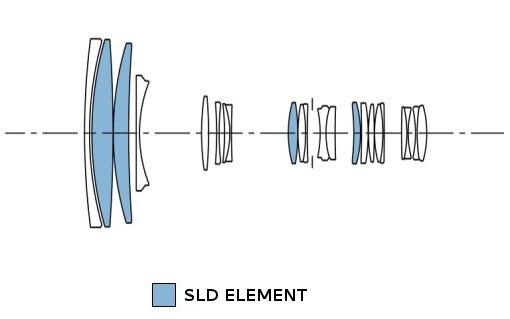 |
The buyer gets a very generous selection of accessories included in box: a hard case, a tripod socket, a petal-type hood, a step-down ring for 86 mm filters and both caps.
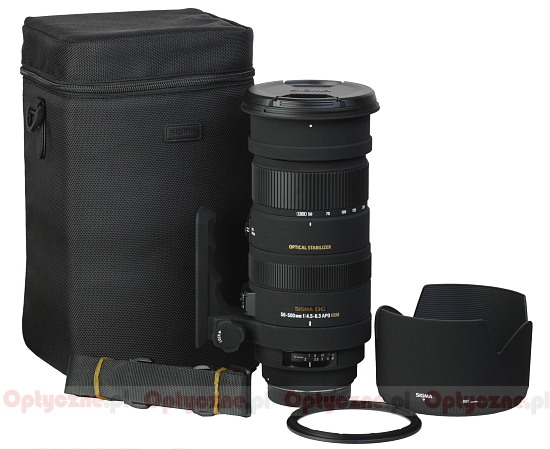 |
Image stabilisation
Although most of manufacturers, which have launched lenses with the image stabilization system recently, ensure that it can be 4 EV efficient, our tests show that it is rarely the case. The Sigma, tested here, was no exception to the rule.
The stabilization test was conducted at 500 mm focal length, with the exposition times ranging from 1/800 to 1/13 of a second, by taking between 20 and 60 photos for each of them with the stabilization switched on and off. After that, a percentage of blurred photos for each exposure was calculated. That percentage, as a part of the function of exposure time expressed in EV (where 0 EV corresponds to an exposure time of 1/500 of a second) was presented on the graph below.
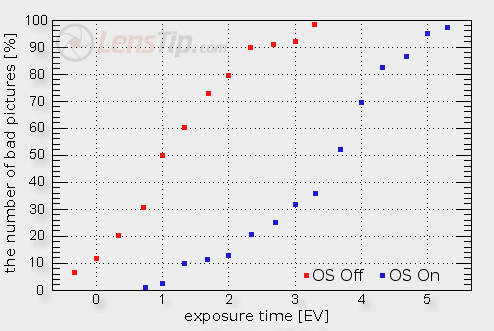
The maximum distance between these two curves is the measurement of the stabilization efficiency. Here it amounts to about 2.7 EV - significantly lower than the declared value of 4 EV. On the other hand, though, you should remember that such rivals as a Canon 100-400L and a Nikkor 80-400 VR are equipped with older stabilization modules which efficiency is at the level of 2 EV. The same value was noted in the case of other models, already tested by us: a Sigma 120-400 mm OS and a 150-500 mm OS. The Sigma’s 50-500 mm OS stabilization is the most efficient in this group and it gives it undoubtedly an advantage. Of course nobody would get angry if in reality it was even higher than 3 EV …






